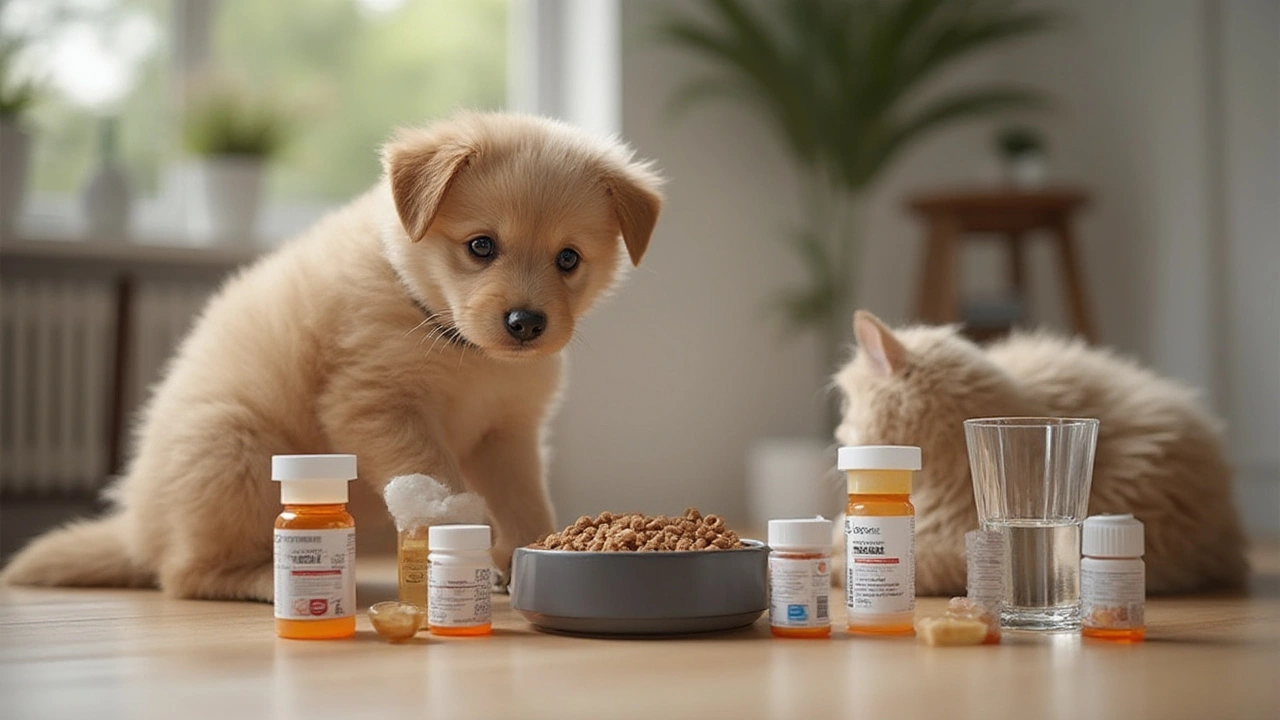Imagine you just walked into your regular vet’s clinic with your limping lab, Molly, the smell of disinfectant thick in the air. You hear the words “cefpodoxime,” and suddenly your brain stutters—what does that do, again? If you’ve got pets, especially dogs and cats, this antibiotic has probably crossed your path even if you didn’t notice. It’s not an exotic medicine, but its impact runs deep, especially for skin infections that don’t back down with old-school penicillin. Let’s get practical: you want your fur kid healthy, but none of us want to blindly trust the name scribbled on a tablet bottle. I’ve had to look up these meds at 2 a.m. with my daughter Tilda trying to calm our rescue terrier with a hot spot that looked straight out of a horror movie. Here’s the real deal on cefpodoxime—what it is, how and when vets use it, and the must-know details before you fill that prescription.
What is Cefpodoxime and Why is it Used in Pets?
If you’ve ever heard of cephalosporin antibiotics, cefpodoxime fits right in there as a third-generation champ. It’s not some new-fangled wonder drug, but what sets it apart is its power against certain bacteria that love to trigger stubborn infections in cats and dogs. The FDA gave its nod to cefpodoxime for veterinary use back in the early 2000s. Since then, you’ll find it on the shelf in most clinics, especially marketed under names like Simplicef. It’s a go-to for a reason: one pill a day suffices for most dogs, meaning you don’t need to battle your German shepherd twice daily with a pill gun.
Cefpodoxime is great for skin infections, like pyoderma—those nasty crusty, oozing lesions that can make your pooch realize the cone of shame was actually mercy. It shines when staph bacteria (specifically Staphylococcus pseudintermedius, which is way more common than you think) are at fault. Many vets turn to it when their regular amoxicillin or penicillin options flop. More than just skin, it can tackle bladder infections and soft-tissue issues, but it isn’t for everything. It won’t kill viruses, doesn’t touch fungal organisms, and isn’t magic for ear infections since it doesn’t target the most common bacteria that show up there.
Research out of veterinary colleges, including University of Georgia and Purdue, consistently puts cefpodoxime at the top for uncomplicated skin infections: about 80-90% of bacterial pyodermas respond within two weeks if you stick with the dosing. The kicker? Giving it with food actually boosts absorption. No more chasing your dog for a sneak-attack pill drop; just hide it in a piece of cheese, and you’re set. The tablets are even chewable. And for busy pet parents, dosing once daily cuts your chance of missing a pill compared to antibiotics that need twice-daily commitment.
What about cats? They react to many meds weirdly, but cefpodoxime gets a passing grade. It’s sometimes used for cats with abscesses or bite wounds—think of those battle scars outdoor cats love collecting. Just know, not every infection is fair game, and your vet will decide when it’s actually safe for your cat’s kidneys and gut.

Precautions: What You Should Know Before and During Use
This is the part where reading the fine print matters. Cefpodoxime is considered safe for most healthy adult dogs, but you’ve got to keep a few red flag warnings in mind. Start with allergies—if your pup has reacted badly to penicillins or other cephalosporins, steer clear. About 10% of dogs who are allergic to penicillins could be allergic to cephalosporins like cefpodoxime. Signs of trouble? Hives, sudden swelling, vomiting, difficulty breathing. If that happens, stop the drug and call the vet, no exceptions.
Kidney function is the big watch-out, especially for older pets or those with known kidney disease. Cefpodoxime leaves the body through urine. If the kidneys lag, the drug can build up and become toxic. Some vets will run blood work before starting, sometimes after a few weeks—especially if the infection is chronic or the pet is older than eight. The same check applies for liver disease. Cats, as usual, can react a little unpredictably, so low dosing is the rule, and they’re monitored closer if the course drags past a week.
Then you’ve got the risk of diarrhea or vomiting. Some dogs don’t skip a beat, but about 5-10% will have a tummy upset. Usually, this shows up in the first couple of days. If vomiting is mild and happens only once or twice, your vet may have you keep going, but severe or bloody vomit/diarrhea is always worth a call. Cats are notorious for hiding GI issues, so keep an eye on litter box activity and sluggish behavior. The good news? Most side effects disappear when you stop the med.
Interactions matter. If your pet is on antacids, some forms of iron, or certain arthritis meds (like carprofen or NSAIDs), always double-check with your vet. Cefpodoxime can sometimes interact, although these cases are rare. Also, if your dog has diabetes, antibiotics can sometimes mess with blood sugar levels—nothing drastic with cefpodoxime, but if your vet is monitoring numbers, don’t forget to remind them of the new medicine in the mix. Puppies and kittens? Usually, it’s not a first choice before 8 weeks of age—safety only gets a green light after that timeline, based on animal weight.
| Cefpodoxime Fact | Detail |
|---|---|
| Antibiotic Class | Third-generation cephalosporin |
| Common Veterinary Brand | Simplicef |
| Main Target Infections | Skin (pyoderma), soft tissue, wounds |
| Dosage Frequency | Once daily |
| Key Side Effects | Vomiting, diarrhea, allergic reaction |
| Cat Use | Sometimes, especially for abscesses |
| Kidney/Liver Warning | Yes; monitor in compromised pets |
Here’s something most parents of itchy dogs don’t realize: even if your dog seems better in three days, finishing the course (usually 1-3 weeks) is non-negotiable. Bacteria left behind can turn into resistant super-bugs—no joke. By stopping early, you could turn a fixable infection into a chronic nightmare that’s tougher (and pricier) to treat.

Tips for Pet Owners: Getting the Best Results with Cefpodoxime
You’ve got the prescription, a timeline, and a hopeful pup ready for relief. Success comes down to sticking to the plan—no playing pharmacist. Here are a few everyday tricks and details to help make cefpodoxime as easy and effective as possible:
- Give cefpodoxime with food to help absorption and cut down on GI upset. Hide it in a treat or smear with peanut butter if your pet’s picky.
- Store the medicine properly—tablets last at room temperature, but if your vet whips up a liquid suspension, it usually needs fridge life and only lasts up to two weeks.
- Missed a dose? If you remember within 12 hours, give it right away; if it’s almost time for the next dose, skip the missed one and get back on track—never double up!
- Watch for allergic reactions, especially after the first couple of doses. If your dog shows swelling, trouble breathing, or sudden collapse, get emergency help.
- Cefpodoxime usually starts to work in 2–3 days. Don’t be discouraged if you don’t see immediate results—some skin infections need the full course to knock out all the bacteria.
- Try to take a few before-and-after photos as you go, especially if the infection is visible. Vets appreciate updates, and you’ll see progress that might be hard to notice day by day.
- Keep your pet from licking, scratching, or biting the infected area. An e-collar or pet shirt saves you more headaches than you think—and prevents re-infection.
- If your pet has chronic infections, talk with your vet about underlying causes—some skin bugs thrive if allergies, mites, or thyroid issues aren’t treated at the root.
- Side effects like upset belly? Plain-cooked chicken and rice works as a bland diet for a day or two if your vet agrees.
- Never give cefpodoxime prescribed to one pet to another. Dosage and safety depend on weight and species—a dose perfect for a shepherd could be toxic to a tiny cat.
For data fans, less than 1% of dogs need to stop cefpodoxime due to side effects, according to studies out of Texas A&M’s vet program. Also, results show cefpodoxime clears up about 85–90% of first-time skin infections within 14 days if combined with good wound hygiene—trimming hair, gentle cleaning, and avoiding harsh shampoos. Resistant infections might need cultures or sensitivity testing. Your vet can swab the sore, grow bacteria in a lab dish, and confirm if cefpodoxime is the right call or if you need to level up to something stronger.
If Tilda were writing this, she’d tell you there’s a weird satisfaction in seeing a “before” picture of a balding, crusty patch next to an “after” photo with pink healthy skin and full fur. I’ll be honest: the sense of relief is real, and less guilt means happier days for both you and your pet. When in doubt, always circle back to the vet—Google can give you quick info, but nothing replaces an expert who’s seen it all face to face. As common as cefpodoxime is, every pet is different and deserves the personalized plan.






Aayush Shastri
This is a very informative post about cefpodoxime use in our beloved pets. It's essential that pet owners understand proper dosing to avoid any harmful side effects. Having known a few people who tried antifungal medications on their pets without vet advice, I think this guide really fills a knowledge gap.
One thing I'd like to add is the importance of completing the full course prescribed by the vet, even if the pet shows signs of recovery early. Stopping antibiotics prematurely can lead to resistance, which complicates treatment in future illnesses. It's great to see that the article includes real pet care tips—these practical insights make all the difference for daily pet management.
Could anyone here share their experiences with cefpodoxime, especially any unexpected reactions or benefits? Also, what precautions would you recommend besides those listed here?
Hannah Gorman
Honestly, while this post tries to be informative, I feel it barely scratches the surface of the complexities involved in prescribing cefpodoxime for animals. The dosage that might work for one dog or cat could be absolutely inappropriate for another due to variations in breed, age, weight and even underlying health issues.
Moreover, the side effects enumerated seem generic and do little to prepare a pet owner for the real risks involved, from allergic reactions to impacts on liver and kidney functions which are far more subtle and insidious. I would have liked this article to expand significantly on the nuances of veterinary monitoring during the treatment timeline.
In my experience, and having spoken to numerous vets, the best advice is to never self-prescribe or administer without direct veterinary supervision because this is where many mistakes happen, often with tragic outcomes.
Calandra Harris
Honestly, why are we even debating this? Cefpodoxime is clearly the superior choice for treating infections in dogs and cats. If you’re second guessing a vet’s recommendation or own attempts at using it based on some vague concerns about side effects or dosage precision, you’re just overcomplicating an otherwise straightforward matter. We have science and standardized prescriptions for a reason.
Trying to micromanage or add unnecessary layers of precaution only delays healing and exposes pets to untreated infections for longer periods. We need to trust our experts and those who know veterinary pharmacology best instead of indulging in baseless fears and what-ifs that have no foundation in solid veterinary practice.
Let’s cut through all the noise and get practical.
Dan Burbank
There's a certain... shall we say, lack of sophistication in how some are approaching cefpodoxime usage for companion animals here. This is a drug that demands respect and a comprehensive understanding of bacterial resistance profiles, pharmacodynamics, and patient-specific idiosyncrasies. The dismissal of these factors is frankly alarming.
In my opinion, the article ought to have provided more elaboration on bacterial spectrum coverage and contraindications beyond the typically mentioned ones. For instance, pets with pre-existing hepatic conditions truly require a nuanced approach; any veterinary professional worth their salt would attest to that.
Furthermore, there's an art to dosing that goes beyond mere milligrams-per-kilogram metrics. A comprehensive veterinary examination paired with laboratory testing optimizes outcomes and minimizes risks. It's a disservice to suggest otherwise.
Anna Marie
I appreciate this thorough post on cefpodoxime use in dogs and cats. It's so important for pet owners to have access to reliable information that helps them understand why this antibiotic might be prescribed and what to watch out for during treatment.
From an empathetic perspective, I’d say the tips about monitoring side effects like vomiting or diarrhea are crucial because they can signify when to seek veterinary advice early on. Also, the reminders about avoiding self-medication are invaluable because we all want to do what’s best for our furry friends, and sometimes good intentions can lead to harm.
Would be great if someone could share any personal experiences where early intervention based on side effects helped their pets recover smoothly while on cefpodoxime.
Abdulraheem yahya
I’m totally with the point about completing the antibiotic course, it’s something that many overlook when caring for pets. I remember once I stopped giving cefpodoxime to my dog early because he seemed better, and the infection came right back stronger!
Also, the post mentions some real pet care tips that are extremely helpful, like how to make sure the pet actually swallows the pill and doesn’t spit it out — many owners underestimate how tricky meds administration can be.
In my country, access to veterinary care can sometimes be limited, so guides like this really empower people to make informed decisions and ask the right questions at the clinic. Sharing experiences here could add so much value for pet owners worldwide.
Sen Đá
Although this guide is generally useful, I must emphasize the absolute necessity for owners to consult veterinary professionals prior to administering any antibiotic such as cefpodoxime. Self-medication without proper dosage calculation and assessment of animal health status might lead to serious complications including antibiotic resistance or aggravated symptoms.
Furthermore, dosing in veterinary medicine is not a one-size-fits-all parameter; breed-specific pharmacokinetics must be considered thoroughly. This post could be enhanced with warnings about potential drug interactions commonly overlooked by laypersons.
Responsibility lies not only with the pet owner but also with the veterinary community to educate and enforce stricter guidelines on antibiotic dispensation.
LEE DM
Really enjoyed reading this piece. It strikes a fine balance between detailed medical explanation and practical guidance for the average pet caretaker. One thing that resonated with me was the emphasis on understanding side effects and the need for prompt veterinary consultation rather than panic or guesswork.
Veterinary medicine often mirrors human medicine in its complexity, but the communication gap from vet to owner can create confusion. Posts like this help bridge that gap by demystifying antibiotics like cefpodoxime and encouraging responsible use.
Would anyone recommend additional resources or communities that focus on pet health education and antibiotic stewardship?
mathokozo mbuzi
This guide is well structured, but I would like to see more on how cefpodoxime compares with other antibiotics commonly used in veterinary settings. Knowing when to use this drug over alternatives can really influence treatment outcomes.
Moreover, understanding local bacterial resistance trends should influence prescription practices, so perhaps adding information on how vets can access or interpret such data could elevate this article.
Has anyone here had experience switching their pet’s antibiotic therapy based on resistance patterns? Sharing these stories might provide real-world context to the technical guidance.
Penny X
While I appreciate the effort to inform, it’s critically important that we acknowledge how improper antibiotic use in pets contributes to the larger fight against antimicrobial resistance. This isn’t just a pet health issue; it’s a public health crisis.
The guide should have more strongly emphasized that cefpodoxime must never be purchased or used without prescription, that dosage adherence is non-negotiable, and that veterinary oversight is mandatory throughout treatment.
Pet owners must be educated on their role not only in healing their animals but also in protecting community health by fighting resistance. This is a moral imperative.